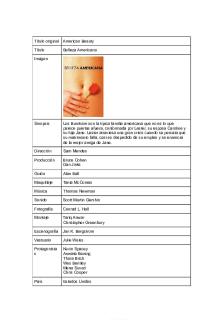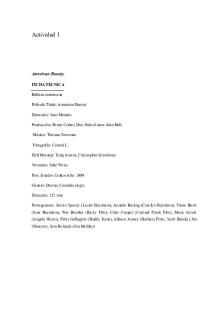Real Beauty Vs Cliche Beauty PDF

| Title | Real Beauty Vs Cliche Beauty |
|---|---|
| Author | joshua williams |
| Course | Shakespeare |
| Institution | University of Phoenix |
| Pages | 5 |
| File Size | 91.1 KB |
| File Type | |
| Total Downloads | 22 |
| Total Views | 143 |
Summary
A comparison on a poets thoughts of beauty in the 18th century...
Description
Real Beauty vs. Cliché Beauty Page | 1 Real Beauty Vs. Cliché Beauty
Joshua Williams
LIT/304
University of Phoenix
1/15/2017
Real Beauty vs. Cliché Beauty Page | 2 Introduction Real Beauty and Cliché Beauty is a common theme in plenty of poems written by Shakespeare and is a universal constant in his plays as well. Cliché Beauty is often seen in reference to the outer beauty or what someone looks like based on appearances which are what is often studied in this world. Real Beauty can be described as what people do not see in others, the inner beauty such as personality traits and such these factors hold a stronger impact on someone who has a different outlook than others. Shakespeare's poems seem to fluctuate between cliché beauty, real beauty, love, and lust as well as other different themes shown throughout his writings. Sonnet 131 and Sonnet 128 of the Dark Lady Sonnets focus on both Outward Beauty and an eternal Beauty that leaves a lasting impression on the reader. Shakespeare focused the Dark lady Sonnets on two separate themes, yet the power of Real Beauty and Cliché Beauty can be picked up right some the first line of these sonnets. Sonnet 128 Sonnet 128 highlights the ethereal beauty that a woman possesses when doing something that they enjoy. he makes a large comparison between beauty and music; which is a great comparison because plenty of music can give off an ethereal almost surreal feel with its beautiful sound. This poem can also
ot i c k l ed,t heywoul d be given a sexual overtone if looked at in the aspect of love vs. lust. “ Tobes c hanget hei rs t at eAnd situation with those dancing chips, O'er whom thy fingers walk with
gentle gait, Making dead wood more bless'd than living lips.”[ CITATION Bev14 \l 1033 ] This line of the poem mentions fingers dancing across the instrument bringing to life a sound that holds an eerie yet mystical sound, the state changes as the sound leaves the instrument while they move across it with a gentle gait. Making the dead wood sing and be more blessed than living lips. This line can be seen as a comparison of her voice to the sound of a lyre which holds a haunting and ethereal sound; it can also be seen as a line of jealousy that something has her focus more than he does. In this poem, Beauty is treated more as an object shown only when the people
Real Beauty vs. Cliché Beauty Page | 3
are alone and it can be shown in an intimate fashion. It can also be described as he just wants to sit there and listen to her sing or play an instrument. Shakespeare’s use of Imagery makes it where narrowing down to a singular theme in his poems is difficult because in this poem it could also be a lament of a skill lost, the thing he loved about her she can no longer do and it upsets him to see her struggling to revive the skill when all he wants is her to be his and focus on them. In the Dark Lady Sonnets Beauty is treated as both a timeless and eternal item that never fades, while outward beauty fades and changes as time progresses. [ CITATION Oth17 \l 1033 ]Sonnet 131 speaks of the beauty in an angry fashion like he was betrayed by it something had happened between him and the Dark Lady that made him feel lead astray by her words or beauty, while Sonnet 128 mentioned of how he fell for her beauty. Cliché beauty can be described by this as a manner of being used to lure men to a lapse of judgment leading them to make a mistake. [ CITATION Oth17 \l 1033 ] Sonnet 131 The beginning of sonnet 131 shows anger yet as the sonnet progresses it also shows how much that he cared for her. This poem addresses the beauty that she used to lead him into her graces and fall for her gave willingly to another this lead to the fury leaping off from the first line. “Thouar tast y r annous ,s oast houar t , As those whose beauties proudly make them cruel; For well thou know'st to my dear doting heart Thou art the fairest and most precious jewel. Yet, in good faith, some say that thee behold, Thy face hath not the power to make love groan;”[ CITATION Bev14 \l 1033 ] He felt betrayed by her, yet he still loved her for her beauty and would do anything to keep her. The beauty of the Dark lady is described in a more physical aspect throughout this sonnet and exposed his more tender side in the poem.[ CITATION Oth17 \l 1033 ] Thus the beauty in this one can be seen in the role of a male toward a female it
Real Beauty vs. Cliché Beauty Page | 4
also shows that Real Beauty can be found in the opposite gender as well. Shakespeare has managed to incorporate all forms of beauty in his poems each one maintaining a delicate balance between Real Beauty and Cliché Beauty. Treatment of the theme In both Sonnets, Shakespeare used two different imageries to go over Real Beauty and Cliché Beauty that was seen during the time period that they were written in. Sonnet 128 held a focus that Real Beauty is deeper than just the skin, while everything can look nice and sound nice a person’s true worth can be seen on the inside, this true worth is their Real Beauty. When Reading Sonnet 131, the anger that Shakespeare felt was just there from beginning to the end even though the imagery changed from anger to a flowery description of how she betrayed him, this goes on to show that even someones Real Beauty can be Cliché because they can just not truly care about someone even if they hold that person close to their heart. He also seems to forgive her for the betrayal and want to remain faithful to her if she is willing to change and remain faithful to him. So he is still looking at her trying to find a sliver of kindness that holds onto him with a strong and powerful beauty that can go just overpower her desire to be with another. Conclusion Shakespeare manages to find a way to utilize the theme in different aspects while keeping in mind that the subject of his sonnets is a subject of his devotion their Beauty to the point that even it is cliché he will bring it to paper thus immortalizing them in the word. The bard’s gift of words is able to bring the theme home while making you seek out his exact meaning in what he means
Real Beauty vs. Cliché Beauty Page | 5
by Real Beauty Vs. Cliché Beauty. Shakespeare also took the time to bring to a reader’s attention that not all beauty is real even what is on the inside can be faked.
References Bevington, D. (2014). The Necessary Shakespeare (4th ed.). Chicago: Pearson. Themes in Shakespeare's Poems. (2018, 1 13). Retrieved from SparkNotes: http://www.sparknotes.com/shakespeare/shakesonnets/themes.html...
Similar Free PDFs

Real Beauty Vs Cliche Beauty
- 5 Pages

Assignment ent300: Kayman beauty
- 10 Pages

A Womans Beauty
- 3 Pages

Fenty beauty business analyse
- 4 Pages

Ficha técnica American Beauty
- 2 Pages

Maleficent and sleeping beauty
- 2 Pages

Hopkins’ “Pied Beauty”
- 3 Pages

Ohs Essay - 40% Beauty Industry
- 7 Pages

Beauty Pageants are Harmful
- 3 Pages

Ulta Beauty Marketing Plan
- 13 Pages

Concorrência do Antony Beauty
- 3 Pages

Beauty Perception TEST
- 13 Pages
Popular Institutions
- Tinajero National High School - Annex
- Politeknik Caltex Riau
- Yokohama City University
- SGT University
- University of Al-Qadisiyah
- Divine Word College of Vigan
- Techniek College Rotterdam
- Universidade de Santiago
- Universiti Teknologi MARA Cawangan Johor Kampus Pasir Gudang
- Poltekkes Kemenkes Yogyakarta
- Baguio City National High School
- Colegio san marcos
- preparatoria uno
- Centro de Bachillerato Tecnológico Industrial y de Servicios No. 107
- Dalian Maritime University
- Quang Trung Secondary School
- Colegio Tecnológico en Informática
- Corporación Regional de Educación Superior
- Grupo CEDVA
- Dar Al Uloom University
- Centro de Estudios Preuniversitarios de la Universidad Nacional de Ingeniería
- 上智大学
- Aakash International School, Nuna Majara
- San Felipe Neri Catholic School
- Kang Chiao International School - New Taipei City
- Misamis Occidental National High School
- Institución Educativa Escuela Normal Juan Ladrilleros
- Kolehiyo ng Pantukan
- Batanes State College
- Instituto Continental
- Sekolah Menengah Kejuruan Kesehatan Kaltara (Tarakan)
- Colegio de La Inmaculada Concepcion - Cebu



